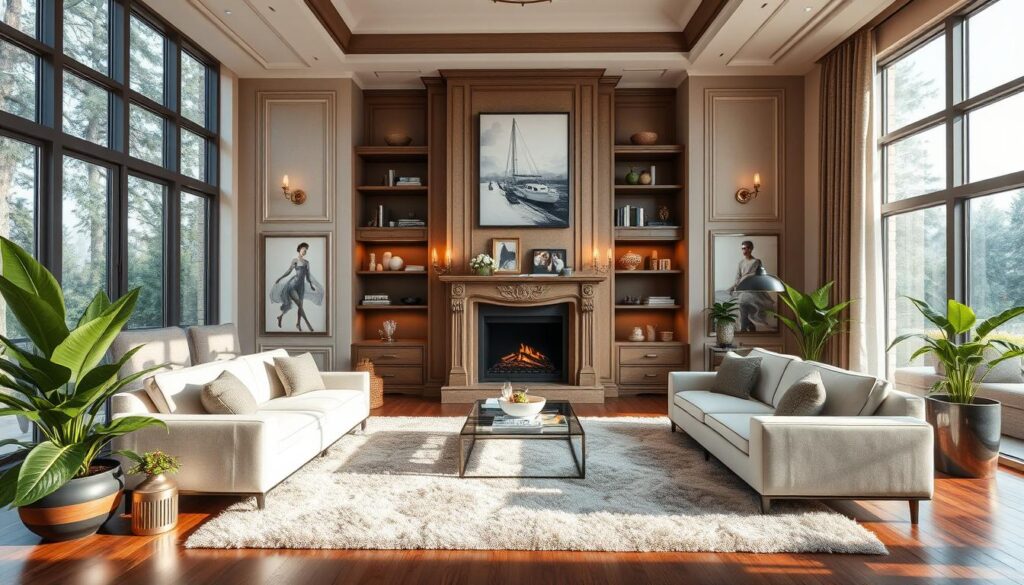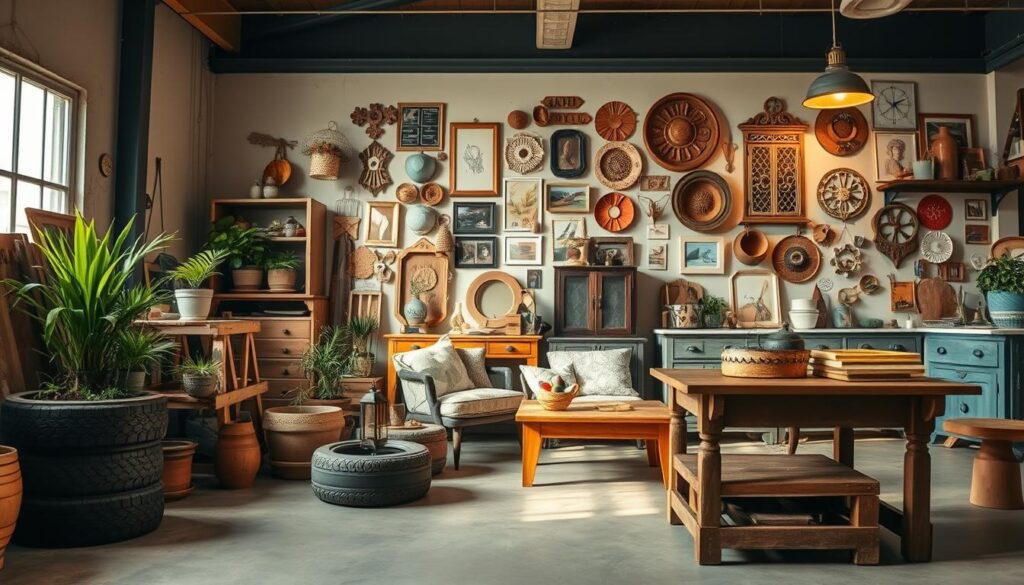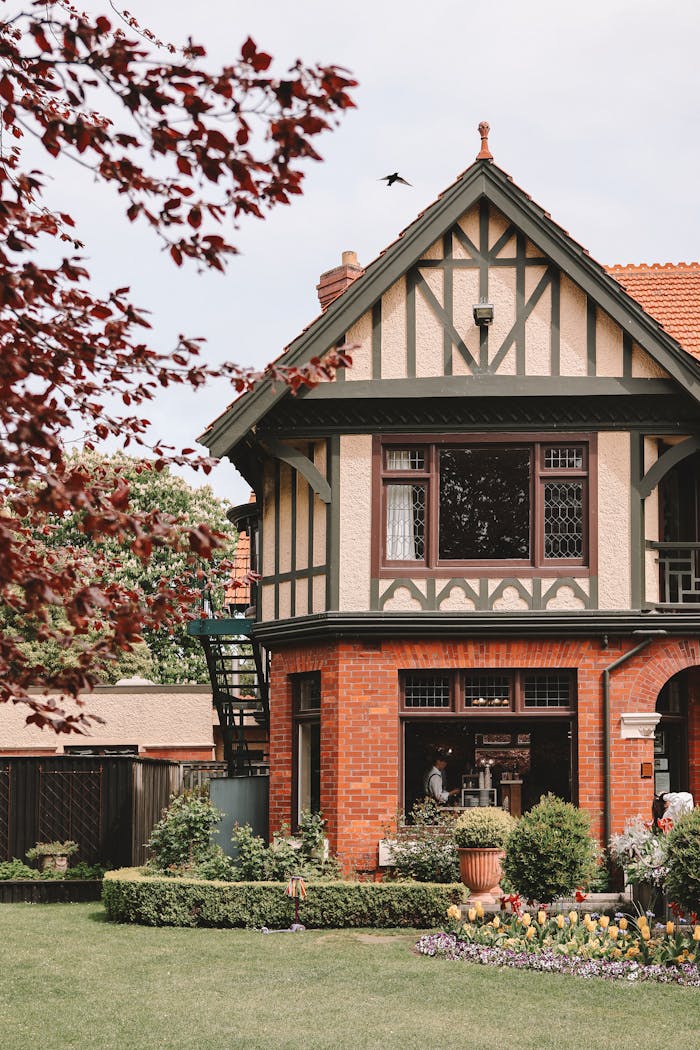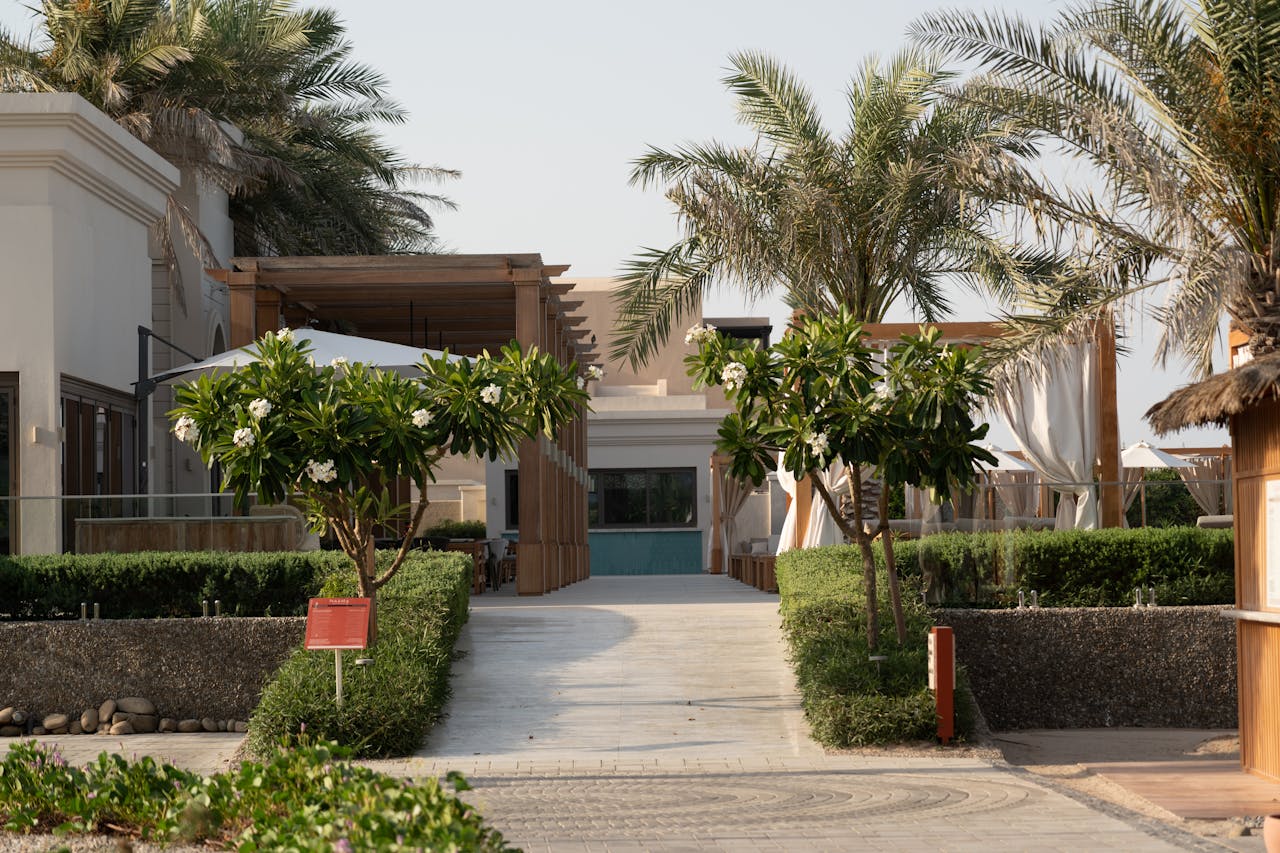Did you know millions of people look for home decor ideas on Pinterest every month? This shows how many are eager to make their homes beautiful and useful.
Resources like Better Homes and Garden (BHG) and eBay play a big role in these design ideas. BHG, in particular, has lots of ideas and products for different tastes.
Exploring home and garden improvement shows us the need for beauty and function. By using ideas from popular sources, we can make spaces that look great and work well.
Key Takeaways
- Millions seek home decor inspiration online monthly.
- Resources like BHG and Pinterest are key influencers.
- Aesthetics and functionality are crucial in home design.
- Popular platforms offer a wide range of design ideas.
- Balancing form and function is essential.
Understanding the Concept of Better Homes and Gardens
Improving our living spaces is key. It’s important to understand how indoor and outdoor areas work together. The idea of better homes and gardens is about making both look good and work well together.
The Importance of a Well-Designed Home and Garden
A well-designed home and garden do more than look good. They also make us feel better. By combining indoor and outdoor spaces effectively, we make our homes more useful and peaceful.
For example, big windows, sliding glass doors, or outdoor kitchens help mix indoors and outdoors. This makes our spaces feel bigger and more connected to nature.
Benefits of Combining Indoor and Outdoor Spaces
Mixing indoor and outdoor spaces has many advantages. It brings in more natural light, better air, and a sense of openness. Gardening tips from Better Homes and Gardens (BHG) show this trend is growing. Homeowners want spaces that are both useful and beautiful.
| Benefits | Description |
|---|---|
| Increased Natural Light | Larger windows and open layouts allow more sunlight into the home. |
| Improved Ventilation | Seamless transitions between indoors and outdoors enhance airflow. |
| Enhanced Lifestyle | Outdoor living areas expand the space for relaxation and entertainment. |
By following the idea of better homes and gardens, we can make spaces that are not just pretty but also useful and green. This way of designing homes encourages outdoor living and helps us connect more with our surroundings.
Key Elements of a Beautiful Garden
To make a stunning garden, focus on the right plants, a nice layout, and calming water features. A beautiful garden is more than just pretty. It’s a peaceful place to escape daily stress. By picking and mixing these elements well, you can make a space that looks great and serves a purpose.
Choosing the Right Plants for Your Climate
Picking the right plants is key for a successful garden. Your area’s climate affects which plants will do well. Native plants are a smart choice because they fit your local climate and soil. Think about temperature, rain, and sunlight when picking plants. For more gardening tips, talk to local nurseries or gardening experts.
Designing Garden Layouts for Maximum Appeal
A good garden layout makes your outdoor space more appealing. Think about the principle of balance to mix plants, hardscapes, and water features well. Use different heights, textures, and colors to make it interesting. Doing DIY projects like building paths or planters can make your garden unique.
| Layout Element | Description | Benefits |
|---|---|---|
| Pathways | Meandering paths that guide visitors through the garden | Encourages exploration, adds visual interest |
| Plant Beds | Carefully planned beds that showcase a variety of plants | Creates a colorful display, attracts wildlife |
| Water Features | Ponds, fountains, or other water elements | Adds tranquility, creates soothing sounds |
Incorporating Water Features for Tranquility
Water features bring peace and calm to your garden. The sound of water can be very soothing. You can choose from small ponds, fountains, or even a simple birdbath. Think about your garden’s size and style when adding water features. Doing DIY projects for water features can be fun and rewarding.
Creating Inviting Outdoor Living Spaces
Creating an inviting outdoor living space is more than just adding furniture. It’s about making an extension of your home that blends well with indoor areas. As we spend more time at home, the need for well-designed outdoor spaces has grown.
Essential Furniture and Accessories for Patios
Furnishing your patio requires a balance of comfort, durability, and style. Weather-resistant materials are key, as they stand up to the elements and need less upkeep. Mix seating options like sofas, armchairs, and dining sets for a versatile space.
Adding throw pillows, outdoor rugs, and decorative planters can make your space personal. Choose items that match your home’s interior design for a cohesive look.
Lighting Ideas to Enhance Ambiance
Lighting is vital for your outdoor space’s ambiance. String lights and lanterns create a warm glow. Solar-powered lights are eco-friendly. For task lighting, LED strips under furniture or along paths work well.
For a dramatic effect, mix light sources. Tabletop torches with overhead lighting create a layered look that boosts ambiance.
Cooking and Dining Areas: A Guide to Outdoor Kitchens
Outdoor kitchens are now a staple in modern homes, perfect for cooking and entertaining outside. Design your outdoor kitchen with the work triangle concept in mind. This means placing your grill, sink, and cooking area in a triangle for better efficiency.
| Feature | Description | Benefits |
|---|---|---|
| Outdoor Grill | A high-quality grill is the centerpiece of any outdoor kitchen. | Enhances cooking experience, allows for outdoor entertaining. |
| Countertops | Durable, weather-resistant countertops are essential for outdoor kitchens. | Provides additional prep space, enhances functionality. |
| Dining Area | A comfortable dining area is crucial for al fresco dining. | Encourages outdoor dining, enhances entertainment capabilities. |
By adding these elements, you can make an outdoor space that’s both functional and welcoming. It’s perfect for relaxing, entertaining, or enjoying the outdoors.
Interior Design Tips for a Better Home
Turning your home into a cozy and stylish space is simpler than you might think. A well-designed home looks great and feels welcoming. We’ll look at key elements to improve your living area.

Color Schemes That Elevate Your Space
The colors you pick greatly affect your home’s feel. Soft, neutral tones bring calm, while bold colors add energy. Designers say the right colors can make a room feel bigger, cozier, or more inviting.
Choose colors that match your style and furniture.
Choosing the Right Furniture for Functionality
Choosing furniture is key for looks and use. Think about each piece’s purpose and how it fits your design. For example, a multi-functional sofa can be a comfy seat and a guest bed.
Designers say furniture with multiple uses is smart for today’s homes.
Decor Styles: Modern vs. Traditional
Choosing between modern and traditional decor depends on your taste and home style. Modern decor has clean lines and focuses on function. Traditional decor includes classic pieces, rich textures, and details.
Try mixing both styles for a look that’s truly yours.
Using these design tips, you can make your home beautiful, functional, and welcoming. Whether updating one room or redoing your whole house, the right choices matter a lot.
Sustainable Gardening Practices
As we work to improve our homes and gardens, we must think about how our gardening affects the environment. Sustainable gardening lets us enjoy a lovely outdoor area while being kind to the planet.
Choosing the right plants is key in sustainable gardening. Native plants are a great pick because they fit well with the local weather and soil. They need less water and care.
Benefits of Native Plants
Native plants offer many advantages, including:
- They use less water
- They need fewer fertilizers and pesticides
- They help local wildlife, like bees and butterflies
Using native plants in your garden helps the environment and makes your space unique and full of life.
Composting 101
Composting is a big part of sustainable gardening. It turns waste into soil that makes plants grow well. You need a mix of “green” stuff (like food scraps) and “brown” stuff (like dried leaves).
Composting tips:
- Make sure you have the right mix of green and brown materials
- Keep the compost pile a bit damp
- Turn the compost often to keep it fresh
Water Conservation Tips
Water is precious in gardening. Here are ways to use less of it:
- Choose plants that don’t need much water
- Use systems to catch rainwater
- Don’t water too much by checking the soil
In summary, gardening in a way that’s good for the planet makes our gardens better and more lasting. By picking native plants, composting, and saving water, we can make beautiful and eco-friendly outdoor spaces.
Smart Home Technology for Better Living
Smart home technology is changing our homes into better places. It makes our homes more efficient, secure, and comfy. It’s not just about making things easier; it’s about making our homes fit our needs better.
One big plus of smart home tech is how it simplifies our lives. With just a button or a voice command, we can manage our home. This includes things like lights and temperature.
Home Automation Devices That Simplify Life
At the core of smart home tech are home automation devices. These devices let us control and check on our home from anywhere. For example, smart thermostats learn our temperature likes and adjust it for us. Smart lights turn on or off based on our daily habits.
Key benefits of home automation devices include:
- Increased convenience through remote access and control
- Enhanced energy efficiency by optimizing energy usage
- Improved home security through integrated surveillance systems
Security Features for Peace of Mind
Home security is a big deal for homeowners. Smart home tech offers top-notch security features. This includes smart door locks, security cameras, and motion sensors. These work together to keep us safe and alert us to any danger.
Some of the security features available include:
- Smart door locks that can be controlled remotely
- Security cameras with real-time monitoring capabilities
- Motion sensors that detect and alert us to movement
Energy-Efficient Gadgets to Reduce Bills
Smart home tech also has gadgets that save energy and lower bills. Smart power strips turn off devices when not used. Energy monitors show us how much energy we use, helping us save more.
By using smart home tech, we make our homes better for the planet and for us. As we look to improve our homes, smart tech is a key part of making our living spaces modern and efficient.
Seasonal Gardening: What to Plant and When
To keep your garden thriving, it’s essential to know what to plant and when, based on the season. Gardening is a dynamic activity that changes with the seasons. It offers a fresh opportunity to enhance your outdoor space throughout the year.
Spring Planting: Flowers and Vegetables
Spring is a time of renewal, making it the perfect season to start planting. Begin with cold-hardy vegetables like broccoli, spinach, and lettuce. For flowers, consider tulips, daffodils, and hyacinths, which thrive in the cooler temperatures of spring.
When planning your spring garden, it’s also a good idea to check the last frost date for your area. This ensures you’re not planting tender vegetables too early.
Summer Care: Maintenance Tips for a Thriving Garden
Summer brings warmth and long days, ideal for many plants to flourish. But, it also means more maintenance. Regular watering is crucial, but be mindful of overwatering, which can be detrimental. Mulching around plants helps retain moisture and suppress weeds.
- Monitor your garden’s health daily.
- Prune plants to encourage growth and prevent disease.
- Keep an eye out for pests and diseases.
Fall and Winter Prep: Protecting Your Plants
As fall approaches, it’s time to prepare your garden for the colder months. Start by cleaning up your garden beds, removing any dead plants, and adding compost to enrich the soil. For perennials, apply a layer of mulch to protect the roots from freezing temperatures.
In winter, protect your plants from harsh weather by using covers or bringing potted plants indoors if possible. This care will ensure your garden is ready to flourish again come spring.
By following these gardening tips and adapting to the seasonal changes, you can enjoy a vibrant and productive garden year-round. Whether you’re a seasoned gardener or just starting out, understanding the rhythm of the seasons is key to successful gardening.
DIY Projects to Enhance Your Home and Garden
With a little creativity, you can make your home and garden a haven. DIY projects add a personal touch and boost your property’s value. Let’s dive into some exciting DIY ideas to get you started.
Creative Ways to Upcycle Household Items
Upcycling breathes new life into old items. You can turn old pallets into garden planters or make a unique coffee table from an old door. Here are some ideas to get you started:
- Turn old jars into herb planters or candle holders.
- Use old wooden crates to create shelving units or storage boxes.
- Transform old t-shirts into reusable bags or cleaning rags.

Building Simple Garden Structures and Decor
Building garden structures and decor can make your garden more beautiful and functional. You can create a trellis for climbing plants or build a simple bench for a cozy reading nook. Some ideas include:
- Building a wooden fence to define your garden space.
- Creating a garden path using stones or gravel.
- Making a birdhouse or bird feeder to attract wildlife.
Indoor Plant Projects for a Fresher Home
Indoor plants purify the air and add nature to your home. You can create a mini indoor garden or propagate plants from cuttings. Here are some tips:
- Choose low-maintenance plants like succulents or snake plants.
- Use a variety of containers to add visual interest.
- Propagate plants from cuttings to share with friends or expand your indoor garden.
Landscaping Ideas to Transform Your Yard
Creating an inviting outdoor space starts with innovative landscaping ideas that reflect your personal style. Whether you’re looking to enhance your home’s curb appeal or create a serene retreat, the right landscaping can make all the difference.
Different Styles: Formal, Informal, and Cottage Gardens
Choosing the right garden style is crucial for transforming your yard. Formal gardens are characterized by their symmetry and structured design, often featuring neatly trimmed hedges and geometric patterns.
Informal gardens, on the other hand, embrace a more relaxed and natural look, with plants and flowers arranged in a seemingly spontaneous manner.
Cottage gardens are a charming blend of both, with a mix of flowers, herbs, and vegetables creating a cozy and inviting atmosphere.
- Formal gardens: symmetry, structured design, trimmed hedges
- Informal gardens: relaxed, natural look, spontaneous plant arrangement
- Cottage gardens: mix of flowers, herbs, vegetables, cozy atmosphere
Using Hardscape to Create Visual Interest
Hardscape elements like patios, walkways, and retaining walls can add significant visual interest to your yard. By incorporating different materials such as stone, brick, or wood, you can create a unique and functional outdoor space.
For example, a well-designed patio can serve as an extension of your living area, perfect for dining or entertaining.
- Choose materials that complement your home’s architecture.
- Consider the purpose of each hardscape element.
- Ensure proper installation for durability.
Maximizing Small Spaces with Vertical Gardening
For those with limited yard space, vertical gardening offers a creative solution. By using trellises, wall-mounted planters, or living walls, you can maximize your space and add greenery to even the smallest areas.
Vertical gardens not only save space but also create a striking visual display.
By applying these landscaping ideas, you can transform your yard into a beautiful and functional outdoor oasis. Whether you’re working with a large garden or a small patio, the right combination of style, hardscape, and gardening techniques can help you achieve your outdoor living goals.
Planning for Long-Term Home and Garden Care
Keeping your home and garden beautiful takes effort and planning. We’ve seen how to make your outdoor space welcoming and your interior functional. But, to keep things looking great, you need a long-term care plan.
Setting a Maintenance Schedule
Having a regular maintenance schedule is key. It helps your garden stay healthy and your home look its best. Tasks like pruning, checking irrigation systems, and seasonal cleaning are important. They prevent bigger problems.
Hiring Professional Help
At times, getting help from professional landscapers is smart. They can guide you on complex gardening projects or tasks you’re not sure about. Companies like Better Homes and Gardens offer great advice on home and garden care.
Budgeting for Improvements
It’s important to budget for home and garden improvements. This helps you focus on what’s most important, plan for the future, and use your money wisely. By thinking about your needs and goals, you can make your home more valuable and improve your life.



